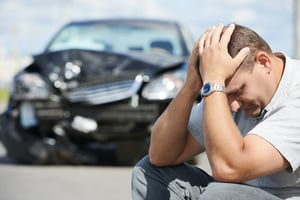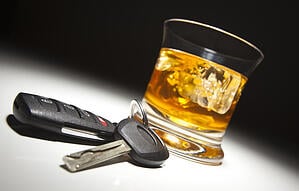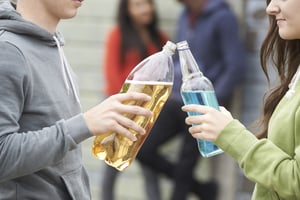Written on Oct 25, 2016 3:31:46 PM
Drunk Driving Accidents Still #1 Cause of Traffic Fatalities in 2016
Topics: driving safety, dui accident
For decades, law enforcement, educators, and numerous advocacy groups like M.A.D.D. have fought to curtail drunk driving. Yet, despite the increasing strictness of drunk driving laws, the implementation of ignition interlock devices, and countless other measures meant to keep people from driving drunk, drunk driving accidents remain the top cause of traffic fatalities.
 According to statistics cited by the National Security Council, alcohol was a cause or contributing factor for 30.8% of all fatalities on the road. This places alcohol ahead of speeding (30%) and distracted driving (26%) as the leading cause for traffic fatalities.
According to statistics cited by the National Security Council, alcohol was a cause or contributing factor for 30.8% of all fatalities on the road. This places alcohol ahead of speeding (30%) and distracted driving (26%) as the leading cause for traffic fatalities.
Why does drunk driving contribute so frequently to traffic fatalities that it remains the top cause in 2016?
Here are a few reasons:
1: DUI Drivers Can Find Workarounds for Their Restrictions
The ignition interlock is an excellent device for preventing a driver who has been convicted of driving under the influence of alcohol from repeating their past mistakes. Unless, of course, the driver mounts the device on a different vehicle from the one they normally drive, or gets a non-intoxicated third party to help them get their car started.
Unfortunately, these “creative” hacks for getting around DUI conviction restrictions put the intoxicated driver back on the road, and put other motorists at risk.
2: Intoxicated Drivers Underestimate Their Level of Impairment
 Driving is one of the most dangerous activities that the average American engages in. Anyone who has ever been on I-275 to Tampa can attest that split-second reflexes and a healthy amount of caution are absolutely necessary to avoid wrecks when other drivers carelessly change lanes or engage in dangerous driving behaviors.
Driving is one of the most dangerous activities that the average American engages in. Anyone who has ever been on I-275 to Tampa can attest that split-second reflexes and a healthy amount of caution are absolutely necessary to avoid wrecks when other drivers carelessly change lanes or engage in dangerous driving behaviors.
Even a small amount of alcohol can impair a person’s reaction time and alertness behind the wheel.
The National Highway Traffic Safety Association (NHTSA) conducted an experiment with 168 test subjects across different age and gender groups to determine the impact of different Blood Alcohol Content (BAC) levels ranging from 0.0% BAC (sober) after drinking a placebo, non-alcoholic solution, to 0.1% BAC (heavily intoxicated) after ingesting alcohol.
The results? With a BAC of 0.04%, average reaction time for all subjects worsened by more than 20%—at 0.1%, the time taken to react to a situation was almost doubled. The study further stated that “major driving-related skills were impaired by BACs as low as 0.02%.” It only takes a few drinks for most people to reach that BAC.
3: Many Drunk Drivers Are Underage, and Underage Drivers Are at Greater Risk of an Accident When Impaired
 According to CDC statistics, about 1 in 10 teens in high school drinks and drives. Also according to the CDC, “young drivers (ages 16-20) are 17 times more likely to die in a crash when they have a blood alcohol concentration of 0.08% than when they have not been drinking” and “teen drivers are 3 times more likely than experienced drivers to be in a fatal crash.”
According to CDC statistics, about 1 in 10 teens in high school drinks and drives. Also according to the CDC, “young drivers (ages 16-20) are 17 times more likely to die in a crash when they have a blood alcohol concentration of 0.08% than when they have not been drinking” and “teen drivers are 3 times more likely than experienced drivers to be in a fatal crash.”
There are a few possible reasons for this increased risk, including:
- A lack of experience behind the wheel;
- Lower body weight makes it easier to reach 0.08% BAC with less alcohol consumption; and
- Increased risk of engaging in distracted driving activities. CDC reports state that “drivers under the age of 20 have the highest proportion of distraction-related fatal crashes.”
All of these factors combine to increase the vulnerability of the young to fatal accidents after consuming alcohol.
Protecting Yourself from Drunk Driving
Almost nobody actively sets out to drive drunk—it’s usually a matter of circumstance. However, it happens all too frequently. So, it’s important to take precautions to protect yourself and your loved ones.
How can you do this? A few tips include:
- Educate Yourself and Your Loved Ones. Make sure that everyone in your family is aware of the dangers of drunk driving. Share the facts with them and be involved. Also, set a good example for others by avoiding drinking and driving. The best thing you can do is be involved.
- Avoid Driving on the Road Right After Happy Hours End or Bars Close. Closing time, and the end of the “happy hour” for your local bar, can mean a lot of intoxicated persons heading to their vehicles all at the same time. If you don’t have a pressing errand to run, try to avoid roadways near popular bars at these times.
- Give Erratic Drivers a Wide Berth. Be on the lookout for vehicles that seem to have a difficult time keeping in their lane or maintaining the speed limit. The drivers of these vehicles may be drunk or may not know how to drive—in either case, you’ll want to give them a wide berth.
- If Going Out to Drink, Sort Out Who the Designated Driver is FIRST. When you’re going out drinking, be sure to arrange for a designated driver beforehand. If in a group of friends, make sure everyone knows who the designated driver is at the start—don’t assume your normally sober friend is going to stay If alone, arrange for a taxi service or call a friend/family member to come pick you up at a set time. DON’T wait until you’re already drunk to arrange a pickup because you’re much more likely to forget to get a designated driver if you’re inebriated.
- Buckle Up. In Florida, it’s the law to wear your seat belt. However, more than just being the law, wearing your seat belt is one of the best things you can do to protect yourself in case of an accident. Additionally, driving a vehicle with a high safety rating and good visibility can further increase your safety on the road at all times.
Unfortunately, drunk driving remains an ever-present danger on roadways all across the country, and Florida’s no exception. As a vacation destination state, we often get visitors during the summer and winter who just aren’t familiar with our roadways and, while looking for a good time, may get a little inebriated.
However, by educating yourself and your loved ones about drunk driving, learning how to stay alert, and using defensive driving techniques, you can limit your risk.
If the worst does happen and you’re involved in an accident with a drunk driver, learn more about what you can do next by calling an auto accident attorney.

